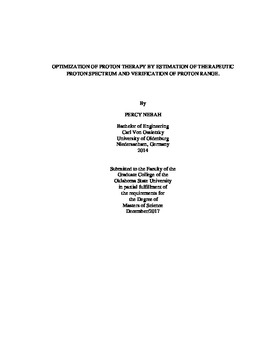| dc.contributor.advisor | Cho, Jongmin | |
| dc.contributor.author | Nebah, Percy Forsuh | |
| dc.date.accessioned | 2018-06-25T16:31:22Z | |
| dc.date.available | 2018-06-25T16:31:22Z | |
| dc.date.issued | 2017-12-01 | |
| dc.identifier.uri | https://hdl.handle.net/11244/300306 | |
| dc.description.abstract | The purpose of this work was to contribute meaningfully to the field of proton therapy. We carried out two projects with a common goal to better understand the nuclear physics occurring around the Bragg peak, to better understand and control dose deposition within the Bragg peak. In the first study, we developed a novel method to measure the peak energy of therapeutic proton beams. Activation of an element with multiple proton interaction cross-sections was used to estimate the proton energy spectrum. Three natural copper foils (50 mm × 50 mm × 0.1 mm) were placed at three different depths in a water-equivalent phantom. The phantom was irradiated with either a near-monoenergetic proton beam or 10 cm spread-out-bragg-peak (SOBP) proton beam 15.4 cm and 15.3 cm range respectively. The activated copper foils created progeny radioisotopes: 63Zn, 61Cu, 62Cu and 64Cu, which decayed through positron emissions. Radiation emitted from these radioisotopes were recorded using a time coincidence system comprised of 3 pairs of scintillation detectors. The relative fractions of the radioisotopes were calculated from the recorded time activity curves, using the least-squares fitting. The relative fraction of each radioisotope is proportional to the convolution of its proton-interaction cross-section and the proton energy spectrum. Our optimization code iteratively solved for the best spectrum peak energy, which resulted in the relative fraction of radioisotopes that matched closest with the decoupled radioisotope fractions. A quantitative evaluation comparing our results with Monte Carlo simulations was performed using the Chi-squared method. There was a good agreement between the optimized and simulated spectra (Chi-square of ? = 0.05 (Level of significance)). In the second study, we developed a novel method for proton range verification. This was based on indirectly detecting Prompt gamma (PG) emitted from a hard water phantom during proton irradiation. High energy PG rays created in a hard water phantom during proton irradiation are intercepted by a lead slab. The PG rays interact by pair production with the nuclei of the lead slab resulting in the production of positron and electron pairs. The positrons rapidly annihilate with the surrounding electrons of the lead slab resulting in the emission of pairs of 511 keV annihilation gamma (AG) rays. The intensity of the AG rays correlates with the intensity of the emitted prompt gamma radiation and was used to determine the range of the proton beam in the phantom. Preliminary results from our method were compared to Monte Carlo simulated results and looked promising. Our system also proved to be ?10 times more sensitive than direct PG detection methods for example, the IBA gamma camera. | |
| dc.format | application/pdf | |
| dc.language | en_US | |
| dc.rights | Copyright is held by the author who has granted the Oklahoma State University Library the non-exclusive right to share this material in its institutional repository. Contact Digital Library Services at lib-dls@okstate.edu or 405-744-9161 for the permission policy on the use, reproduction or distribution of this material. | |
| dc.title | Optimization of Proton Therapy by Estimation of Therapeutic Proton Spectrum and Verification of Proton Range. | |
| dc.contributor.committeeMember | Benton, Eric | |
| dc.contributor.committeeMember | McKeever, Stephen W. S. | |
| dc.contributor.committeeMember | Ahmad, Salahuddin | |
| osu.filename | Nebah_okstate_0664M_15443.pdf | |
| osu.accesstype | Open Access | |
| dc.description.department | Physics | |
| dc.type.genre | Thesis | |
| dc.type.material | text | |
